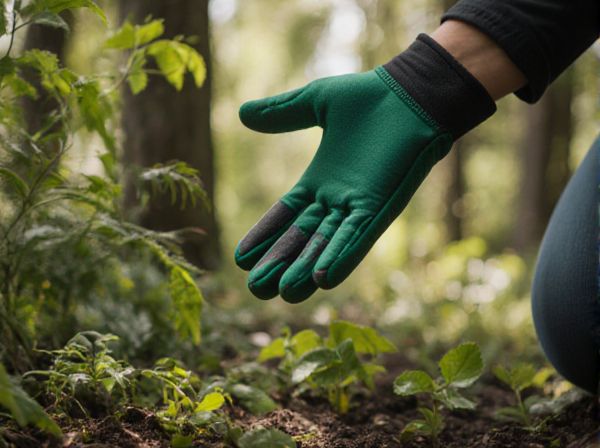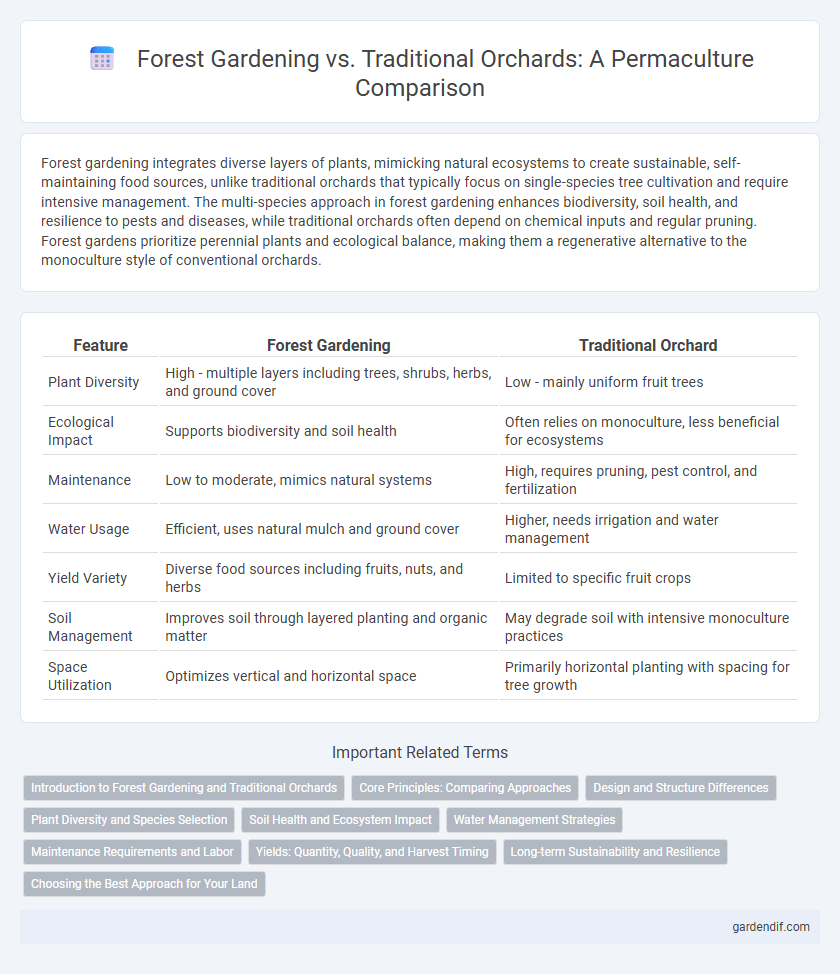
Forest Gardening vs Traditional Orchard Illustration
Forest gardening integrates diverse layers of plants, mimicking natural ecosystems to create sustainable, self-maintaining food sources, unlike traditional orchards that typically focus on single-species tree cultivation and require intensive management. The multi-species approach in forest gardening enhances biodiversity, soil health, and resilience to pests and diseases, while traditional orchards often depend on chemical inputs and regular pruning. Forest gardens prioritize perennial plants and ecological balance, making them a regenerative alternative to the monoculture style of conventional orchards.
Table of Comparison
| Feature | Forest Gardening | Traditional Orchard |
|---|---|---|
| Plant Diversity | High - multiple layers including trees, shrubs, herbs, and ground cover | Low - mainly uniform fruit trees |
| Ecological Impact | Supports biodiversity and soil health | Often relies on monoculture, less beneficial for ecosystems |
| Maintenance | Low to moderate, mimics natural systems | High, requires pruning, pest control, and fertilization |
| Water Usage | Efficient, uses natural mulch and ground cover | Higher, needs irrigation and water management |
| Yield Variety | Diverse food sources including fruits, nuts, and herbs | Limited to specific fruit crops |
| Soil Management | Improves soil through layered planting and organic matter | May degrade soil with intensive monoculture practices |
| Space Utilization | Optimizes vertical and horizontal space | Primarily horizontal planting with spacing for tree growth |
Introduction to Forest Gardening and Traditional Orchards
Forest gardening integrates diverse plant species in layered, self-sustaining ecosystems that mimic natural forests, enhancing biodiversity and soil health. Traditional orchards primarily focus on rows of single-species fruit trees, often requiring more intensive management and input. The permaculture approach of forest gardening promotes resilience and long-term productivity by combining trees, shrubs, herbs, and ground covers.
Core Principles: Comparing Approaches
Forest gardening emphasizes biodiversity by mimicking natural ecosystems with layered plantings including trees, shrubs, herbs, and groundcovers, promoting resilience and sustainability. Traditional orchards focus on monoculture or limited species cultivation, prioritizing high-yield fruit production through systematic pruning and spacing. Core principles of forest gardening prioritize polyculture and ecological balance, whereas traditional orchards emphasize controlled growth and maximized output of selected fruit species.
Design and Structure Differences
Forest gardening integrates diverse layers of plants, including trees, shrubs, herbs, and ground covers, creating a multi-tiered ecosystem that mimics natural forests, unlike traditional orchards that focus mainly on uniform rows of single-species fruit trees. The design of forest gardens emphasizes biodiversity, soil health, and self-sustaining interactions between species, whereas traditional orchards prioritize maximum fruit yield with higher maintenance and external inputs. Structurally, forest gardens have irregular, clustered planting patterns promoting resilience and wildlife habitat, contrasting with the standardized, evenly spaced trees found in traditional orchard layouts.
Plant Diversity and Species Selection
Forest gardening emphasizes high plant diversity by integrating a wide range of edible, medicinal, and nitrogen-fixing species arranged in multiple canopy layers, mimicking natural ecosystems. Traditional orchards primarily focus on a limited selection of fruit tree cultivars, often prioritizing high-yielding varieties with less consideration for understory diversity. The diverse species selection in forest gardening enhances ecosystem resilience, soil health, and pest management compared to monoculture tendencies in traditional orchards.
Soil Health and Ecosystem Impact
Forest gardening enhances soil health through diverse, layered plantings that promote nutrient cycling, organic matter accumulation, and microbial biodiversity, contrasting with traditional orchards that often rely on monocultures and intensive soil management. The polyculture system of forest gardens supports robust ecosystems by providing habitats for a wide range of flora and fauna, improving pollination and pest control naturally, unlike traditional orchards that may depend more on chemical interventions. This ecological approach in forest gardening results in resilient soil structure and balanced ecosystems, fostering sustainability and long-term productivity.
Water Management Strategies
Forest gardening employs layered planting and mulching techniques to maximize water retention and reduce erosion, enhancing soil moisture through natural ground cover. Traditional orchards often rely on regular irrigation systems and managed soil treatments to maintain optimal water levels for fruit trees. Integrating perennial plants in forest gardens creates a self-sustaining ecosystem that conserves water more efficiently than the monoculture approach in traditional orchards.
Maintenance Requirements and Labor
Forest gardening requires significantly less maintenance and labor compared to traditional orchards due to its emphasis on diverse, self-sustaining plant layers that naturally suppress weeds and promote soil health. Traditional orchards demand regular pruning, pest control, and soil management to maximize fruit production, leading to higher labor inputs. The low-input nature of forest gardening aligns with permaculture principles by reducing reliance on external resources and continuous human intervention.
Yields: Quantity, Quality, and Harvest Timing
Forest gardening typically produces a higher diversity of yields throughout the year, combining perennial trees, shrubs, and ground covers that extend harvest timing and enhance ecosystem resilience. Traditional orchards often yield larger quantities of a single fruit crop with more uniform quality but have a limited harvest period focused on peak season. The integrated polyculture in forest gardens improves soil health and fruit quality over time, while conventional orchards rely heavily on monoculture management for predictable production.
Long-term Sustainability and Resilience
Forest gardening emphasizes diverse, multi-layered plant systems that mimic natural ecosystems, enhancing long-term sustainability through improved soil health, biodiversity, and water retention. Traditional orchards typically rely on monoculture fruit tree planting, which can deplete soil nutrients and increase vulnerability to pests and diseases over time. The resilience of forest gardens is bolstered by their ecological complexity, reducing the need for chemical inputs and minimizing environmental impact compared to conventional orchard practices.
Choosing the Best Approach for Your Land
Forest gardening promotes biodiversity by mimicking natural ecosystems, integrating multiple layers of plants, trees, and shrubs to create self-sustaining food systems. Traditional orchards focus on high-yield fruit tree cultivation with minimal understory vegetation, often requiring more maintenance and chemical inputs. Choosing the best approach depends on land size, soil quality, climate, and long-term sustainability goals, with forest gardening ideal for permaculture enthusiasts seeking resilience and traditional orchards suited for commercial fruit production.
Forest Gardening vs Traditional Orchard Infographic

 gardendif.com
gardendif.com